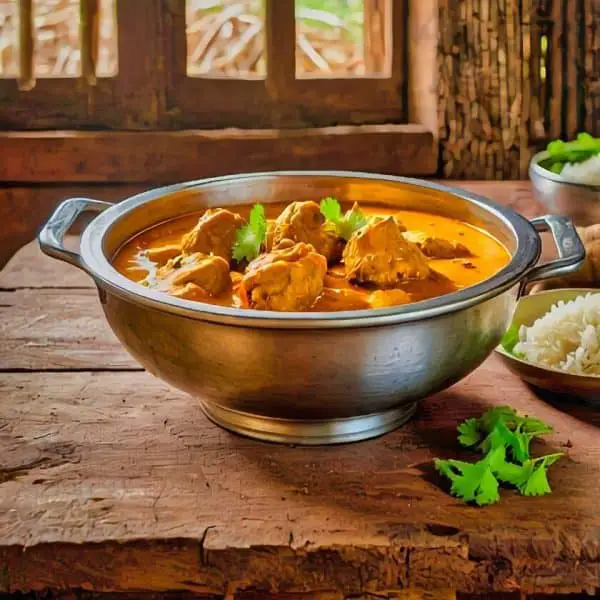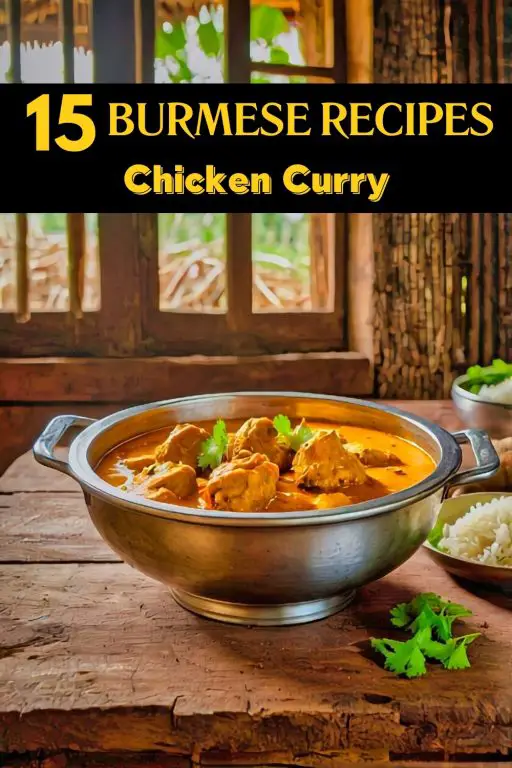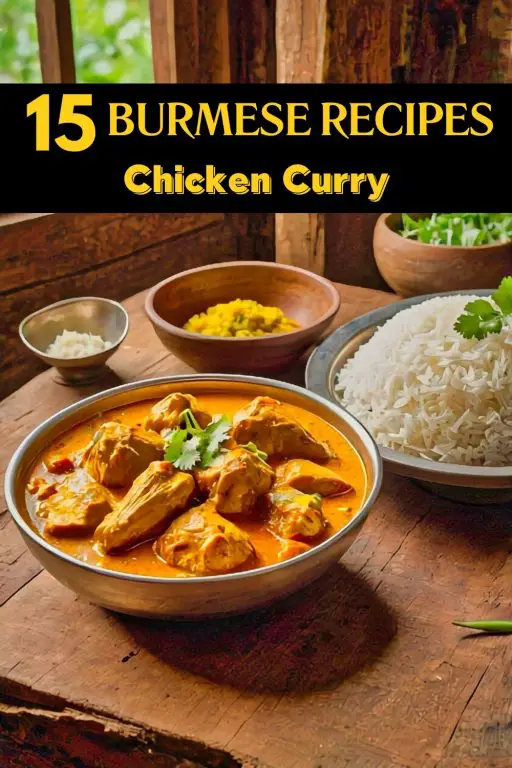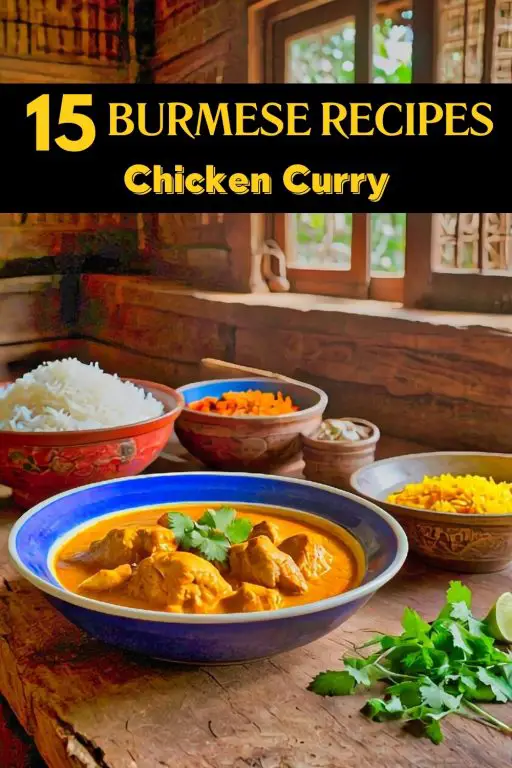I found the Burmese Chicken Curry recipe interesting because it has a rich history and unique flavors. This dish comes from Myanmar and has its beginnings in traditional Burmese cooking, but it has changed over time with influences from nearby areas. Over time, the recipe for Burmese Chicken Curry has changed to include different spices and cooking methods, but the basic process is still the same.
When I made the Burmese Chicken Curry recipe, the first thing I saw was its thick, rich sauce. The way to cook it is by simmering the curry slowly. This helps the flavors mix together and makes a balanced taste. The slow-cooking method makes the chicken more tender, which gives the dish a nice, smooth texture.
The Burmese Chicken Curry recipe is special because it is simple and the flavors blend really well. The sauce has a gentle, earthy flavor that is not too spicy but still has a strong impact. The chicken takes in the curry’s richness, making a dish that is tasty but not heavy. After tasting the dish at a nearby restaurant, I managed to obtain the recipe so I could make it at home.
Ingredients For the Burmese Chicken Curry Recipe
Skinless Chicken Thighs
Turmeric
Ground Cumin
Ground Coriander
Paprika
Salt
Black Pepper
Vegetable oil
Finely Chopped Onion
Minced Garlic Cloves
Grated Ginger
Finely Chopped Small Red Chili Peppers
Tomato paste
Coconut Milk
Bruised and Chopped Lemongrass Stalks
Bay Leaves
Fish Sauce
Lime Juice
Chopped Fresh Cilantro
Cooking Instructions For the Burmese Chicken Curry Recipe
- In a large bowl, combine the turmeric, cumin, coriander, paprika, salt, and black pepper. Add the chicken pieces and toss to coat. Set aside for 15 minutes.
- In a large pot or Dutch oven, heat the vegetable oil over medium-high heat. Add the onion and cook for 5 minutes, until softened.
- Add the garlic, ginger, and chili peppers (if using) and cook for another minute, until fragrant.
- Add the chicken to the pot and cook for 5-7 minutes, until browned on all sides.
- Add the tomato paste and stir to coat the chicken. Cook for 1-2 minutes, until the tomato paste is fragrant and slightly caramelized.
- Pour in the coconut milk and add the lemongrass stalks and bay leaves. Bring to a simmer and let cook for 20-25 minutes, until the chicken is cooked through and the sauce has thickened.
- Stir in the fish sauce and lime juice. Taste and adjust seasoning as needed.
- Serve the chicken curry over steamed rice and garnish with fresh cilantro.
5 Essiential Ingredients for Cooking Burmese Style Food
Here are the top five essential ingredients for cooking Burmese-style food, detailed with their uses and significance:
1. Rice
Description: Rice is the fundamental staple of Burmese cuisine, reflecting its status as a primary food source across Myanmar. It is typically long-grain or jasmine rice, known for its slightly sticky texture when cooked.
Usage: Rice accompanies nearly every meal, serving as the base for curries, soups, and salads. It is essential in dishes like Mohinga, where it is sometimes added directly to the soup or served on the side. In addition to steamed rice, fried rice variations are also popular, often including vegetables, meats, and sometimes even seafood. Rice is versatile, used in both everyday meals and festive dishes.
2. Fish Sauce (Ngan Pya Yay)
Description: Fish sauce is a fermented condiment made from fish and salt. It has a pungent aroma but imparts a deep umami flavour that is crucial to many Burmese dishes. It is usually made from anchovies or other small fish and aged to develop its robust taste.
Usage: Fish sauce is used extensively to season soups, curries, and salads. In dishes like Laphet (fermented tea leaf salad), it adds a salty depth that balances the tangy and bitter notes of the tea leaves. It is also a key ingredient in many dipping sauces and marinades, contributing to the complex flavour profiles typical of Burmese cuisine.
3. Lemongrass
Description: Lemongrass is a fragrant herb with a citrusy, slightly floral flavour. Its stalks are used in cooking, providing a bright, fresh aroma and taste. In Burmese cuisine, it is used both for its flavour and for its fragrant qualities.
Usage: Lemongrass is commonly added to broths and soups, such as Mohinga, to impart a distinctive lemony taste. It is also used in marinades for meat and fish, and in curries to enhance the overall flavour profile. Lemongrass is typically cut into pieces or bruised to release its essential oils, infusing dishes with its aromatic essence.
4. Ginger
Description: Ginger is a spicy, aromatic root widely used in Burmese cooking. It adds warmth and depth to dishes, with a flavour that is both sharp and sweet. Fresh ginger is preferred, though dried or powdered ginger is also used in some recipes.
Usage: Fresh ginger is often combined with garlic to form a flavour base for many Burmese dishes. It is used in curries, soups like Kaukswe (coconut noodle soup), and stir-fries. Ginger’s warming spice complements the complex flavours of Burmese cuisine, balancing out richer elements and enhancing the overall taste.
5. Turmeric
Description: Turmeric is a bright yellow spice known for its earthy, slightly bitter flavour and vibrant colour. It contains curcumin, which is responsible for its distinctive hue and is celebrated for its health benefits.
Usage: Turmeric is integral in many Burmese curries and stews, where it imparts a rich golden colour and an earthy flavour. It is often used in combination with other spices to create the complex flavour profiles typical of Burmese curries. Turmeric is also used in rice dishes and some soups to add both colour and flavour. Its presence is key to achieving the characteristic appearance and taste of traditional Burmese dishes.
Each of these ingredients plays a crucial role in defining the unique flavours of Burmese cuisine, contributing to the rich and varied taste experiences that characterise Myanmar’s culinary traditions.
Most Popular Spices For Burmese Cooking
Burmese cuisine is renowned for its rich, complex flavours, achieved through the use of a diverse array of spices that form the backbone of its culinary tradition. One of the most essential spices in Burmese cooking is turmeric, prized for its vibrant yellow colour and earthy flavour. Turmeric is frequently used in curries and stews, imparting both a warm, robust taste and a distinctive golden hue to dishes. Another crucial spice is cumin, which adds a nutty, slightly smoky flavour that enhances the depth of curries and spice blends. Cumin seeds are often toasted to release their essential oils, making them even more aromatic and flavourful.
Ginger is another indispensable spice in Burmese kitchens, valued for its fresh, zesty heat. It is used both as a fresh root and in powdered form, often combined with garlic to create a base for many dishes, including the beloved Mohinga (fish noodle soup). Garlic itself is a cornerstone of Burmese cuisine, providing a pungent, savoury depth that complements a wide range of dishes from stir-fries to curries.
Chili peppers are crucial for adding heat and complexity to Burmese food. Whether used fresh, dried, or in powdered form, chilis are integral to many dishes, contributing varying levels of spiciness. The use of chili powder or chili flakes allows cooks to adjust the heat level according to personal preference, balancing the spicy kick with other flavours in dishes like Shan Noodles and various curries.
Coriander seeds also play a significant role in Burmese cooking, offering a citrusy, slightly sweet flavour that complements the earthiness of other spices. Coriander is often used in combination with cumin and turmeric to create well-rounded spice blends that define the flavour profiles of many Burmese dishes. Additionally, lemongrass is an aromatic ingredient used to infuse dishes with a fresh, lemony scent, particularly in soups and marinades.
Each of these spices contributes to the distinctive taste of Burmese cuisine, showcasing the intricate balance of flavours that characterises the food of Myanmar. Through their careful use, Burmese cooks create dishes that are not only flavorful but also deeply rooted in the country’s culinary traditions.
FAQ For the Burmese Chicken Curry Recipe
Q: What spices are essential in a Burmese Chicken Curry recipe?
A: A Burmese Chicken Curry recipe typically includes a blend of spices such as turmeric, cumin, coriander, and chili powder. These spices are combined with fresh ingredients like garlic, ginger, and onions to create a deep, flavorful base. The mix of dry and fresh spices provides a balance of heat, earthiness, and fragrance unique to Burmese cuisine.
Q: Can a Burmese Chicken Curry recipe be prepared in advance?
A: Yes, a Burmese Chicken Curry recipe can be made ahead of time and often tastes better the next day as the flavors have more time to develop. Preparing the curry a day before serving allows the chicken to soak in the spices and coconut milk, resulting in a richer flavor. When reheating, you may need to add a splash of water or coconut milk to maintain the right consistency.
Q: Is coconut milk always used in a traditional Burmese Chicken Curry recipe?
A: While many variations of a Burmese Chicken Curry recipe include coconut milk for a creamy texture and mild flavor, some versions use water or broth instead. The inclusion of coconut milk largely depends on regional preferences or personal taste. For those who prefer a lighter dish, using broth instead of coconut milk will still result in a flavorful curry, though it may lack the creaminess associated with coconut-based curries.
Q: What type of chicken is best for a Burmese Chicken Curry recipe?
A: A Burmese Chicken Curry recipe typically uses bone-in chicken pieces, such as thighs or drumsticks, which add more flavor and richness to the dish. The bones help to enhance the overall depth of the curry as it simmers. However, boneless chicken can also be used if preferred, though it may require a shorter cooking time to prevent overcooking.
Q: How can I adjust the spice level in a Burmese Chicken Curry recipe?
A: To control the spice level in a Burmese Chicken Curry recipe, you can adjust the amount of chili powder or fresh chilies used. For a milder curry, reduce the chili content while keeping the other spices like turmeric and cumin the same for balanced flavor. If you prefer a spicier dish, adding more chili or incorporating spicy garnishes like chili oil or fresh green chilies can elevate the heat without overwhelming the other flavors.

Burmese Chicken Curry
Equipment
- large mixing bowl
- Cutting board and Sharp knife
- Large pot or Dutch oven
- Wooden spoon or spatula
- Measuring spoons and cups
- Can opener
- grater for ginger
- Bruising tool (for lemongrass)
- Rice cooker or pot (if serving with rice)
Ingredients
- 2 lbs. boneless, skinless chicken thighs, cut into bite-sized pieces
- 1 tbsp turmeric
- 1 tbsp ground cumin
- 1 tbsp ground coriander
- 1 tbsp paprika
- 2 tsp salt
- 1 tsp black pepper
- 2 tbsp vegetable oil
- 1 onion, finely chopped
- 4 garlic cloves, minced
- 2 inch piece of ginger, grated
- 2 to 3 small red chili peppers, finely chopped (optional)
- 2 tbsp tomato paste
- 2 13.5 oz cans coconut milk
- 2 lemongrass stalks, bruised and chopped
- 2 bay leaves
- 2 tbsp fish sauce
- 1 tbsp lime juice
- Fresh cilantro, chopped, for serving
Instructions
- In a large bowl, combine the turmeric, cumin, coriander, paprika, salt, and black pepper. Add the chicken pieces and toss to coat. Set aside for 15 minutes.
- In a large pot or Dutch oven, heat the vegetable oil over medium-high heat. Add the onion and cook for 5 minutes, until softened.
- Add the garlic, ginger, and chili peppers (if using) and cook for another minute, until fragrant.
- Add the chicken to the pot and cook for 5-7 minutes, until browned on all sides.
- Add the tomato paste and stir to coat the chicken. Cook for 1-2 minutes, until the tomato paste is fragrant and slightly caramelized.
- Pour in the coconut milk and add the lemongrass stalks and bay leaves. Bring to a simmer and let cook for 20-25 minutes, until the chicken is cooked through and the sauce has thickened.
- Stir in the fish sauce and lime juice. Taste and adjust seasoning as needed.
- Serve the chicken curry over steamed rice and garnish with fresh cilantro.





3 comments
The flavors in this chicken curry were perfectly balanced; it was a real treat.
I cant believe they didnt mention the importance of using fresh turmeric in the Burmese Chicken Curry recipe! It makes all the difference in flavor. Trust me, Ive tried it both ways.
I cant believe they left out the crucial step of marinating the chicken overnight for maximum flavor! Its a game-changer, trust me. Who else swears by this secret ingredient trick?
Comments are closed.